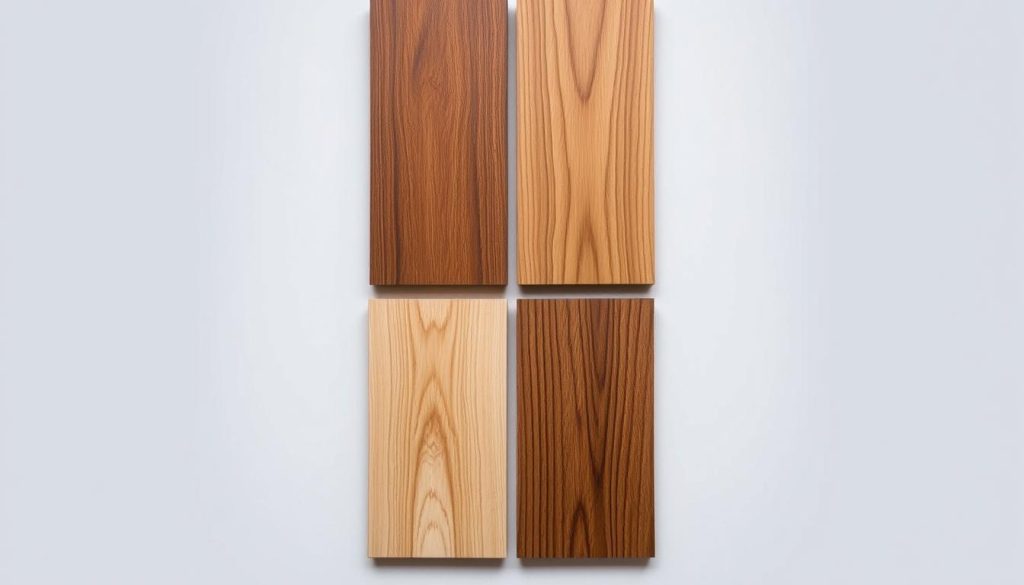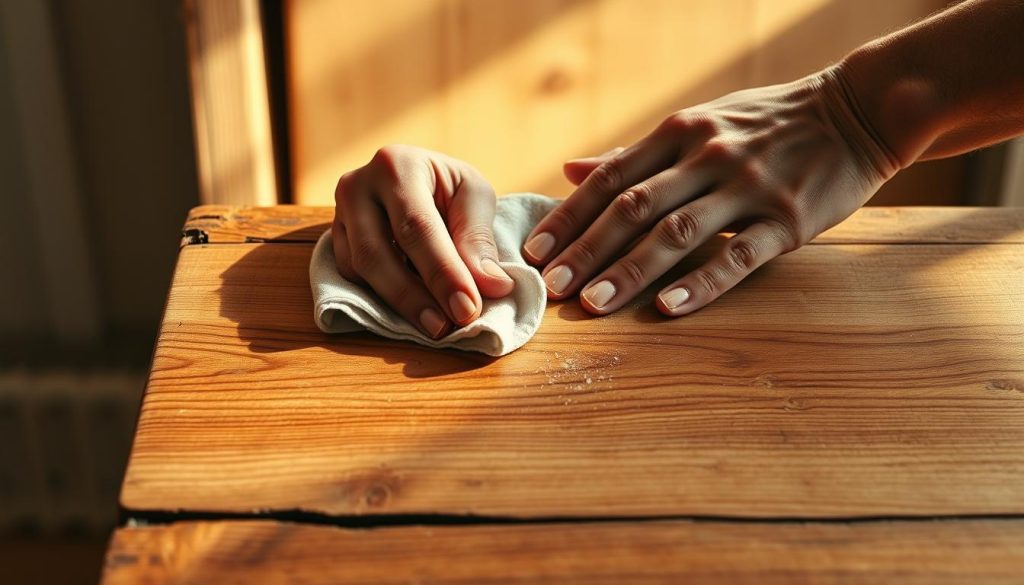Wood countertops have changed kitchen design with their beauty and versatility. Natural wood finishes protect and enhance kitchen surfaces. Butcher block, made from joined wood cuts, is a favorite for warmth and durability.
Eco-friendly finishes are popular for sustainable kitchen solutions. They protect wood and make homes healthier. Choosing the right finish is key to wood countertops’ look and life.
Kitchen experts love natural wood for its unique appeal. Its organic textures and rich tones make kitchens welcoming. With the right care and finish, wood countertops can be a kitchen’s highlight.
Key Takeaways
- Natural wood countertop finishes offer superior protection
- Eco-friendly options enhance kitchen sustainability
- Butcher block provides versatile design opportunities
- Proper finishing extends wood countertop lifespan
- Wood surfaces create warm, inviting kitchen environments
Understanding the Benefits of Natural Wood Countertop Finishes
Choosing the right countertop finish can change your kitchen’s look and feel. It also supports the environment. Natural wood finishes let homeowners create beautiful, eco-friendly spaces. These spaces focus on style and health.
Eco-Friendly Advantages
Non-toxic wood finishes have big environmental benefits. They reduce harmful chemical exposure and lower ecological impact. Sustainable wood finishing options help homeowners make eco-friendly choices.
- Reduced carbon footprint
- Minimized toxic chemical usage
- Renewable resource utilization
- Lower environmental manufacturing impact
Healthier Indoor Environment
Natural wood finishes make indoor air quality better. They remove volatile organic compounds (VOCs) found in synthetic products. Homeowners can enjoy cleaner, safer kitchen surfaces.
- Zero harmful chemical emissions
- Improved respiratory health
- Allergen-free surface treatments
Unique Aesthetic Appeal
Natural wood finishes also bring unmatched visual warmth and character. Each application highlights the wood’s beauty, making kitchens unique and inviting. Synthetic materials can’t match this.
- Rich, natural color variations
- Authentic wood grain preservation
- Timeless design elements
Types of Natural Wood Countertop Finishes
Choosing the right finish is key for protecting and enhancing wooden countertops. The best finishes offer both beauty and practical protection. Knowing the options helps homeowners pick the best for their kitchen.

Wood countertop finishes vary, each with its own benefits. Food-safe finishes are especially important for kitchen areas where food is prepared.
Oils: Natural Protection for Wood Surfaces
- Mineral oil: Goes deep into wood and keeps it moist
- Tung oil: Makes a hard, water-resistant surface
- Linseed oil: Protects wood naturally and highlights grain
Waxes: Adding Extra Layer of Protection
- Beeswax: A natural, food-safe choice that seals well
- Carnauba wax: Adds hardness and shine to wood
Varnishes and Shellacs: Durable Finish Options
Professional varnishes and shellacs give long-lasting protection. They create a strong layer that resists scratches and daily wear.
- Polyurethane varnish: Very durable and moisture-resistant
- Shellac: Dries fast and gives a smooth, attractive finish
When picking a wood countertop finish, think about food safety, durability, and upkeep. Each finish has its own benefits for protecting and enhancing your wood surfaces.
Choosing the Right Finish for Your Kitchen
Choosing the right wood countertop finish is important. It affects both how long it lasts and how it looks. The right finish can make your kitchen look amazing.
Kitchen countertops are a big investment. They can cost between $2,000 and $5,000 for 50 square feet. Knowing what you need is key to making the right choice.
Consider Your Lifestyle
How you use your kitchen matters when picking a finish. Think about these things:
- How often you cook and prepare food
- How many people live in your house
- If you have kids or pets
- What kind of meals you usually make
Assessing Maintenance Needs
Wood countertop finishes need different levels of care. Some need more attention, while others are easier to keep up with.
- Think about how much maintenance you’re willing to do
- Check how often you need to reapply the finish
- Look into professional treatments
Aesthetic Preferences
The look of your wood countertop finish can change your kitchen’s feel. You can choose from glossy to matte finishes. Your choice shows your style and matches your kitchen’s design.
The best wood countertop finish is both practical and beautiful. It makes your kitchen both beautiful and useful, fitting your needs perfectly.
Preparing Your Wood Countertop for Finishing
Before you start applying finishes, you need to prepare your wood countertop carefully. DIY wood countertop finishes require precision and attention to detail. This ensures a professional-looking finish.
Surface Sanding Techniques
Sanding is key to creating the perfect surface for finishes. Here’s how to get started:
- Start with coarse-grit sandpaper (60-80 grit) to remove big imperfections
- Then, use medium-grit sandpaper (120-150 grit) for smoothing
- Finally, finish with fine-grit sandpaper (220-320 grit) for a smooth surface
- Always sand in the wood grain direction to avoid scratches
Cleaning and Conditioning the Wood
After sanding, cleaning is crucial. Use a tack cloth or vacuum with a soft brush to remove dust and debris. Wood conditioning ensures even finish absorption and protects against moisture.
- Wipe the surface with a clean, lint-free cloth
- Apply a wood conditioner suitable for your wood type
- Let the conditioner absorb fully before applying the final finish
Professional woodworkers advise taking your time during preparation. Hurrying can ruin the finish’s appearance and durability.
Application Techniques for Wood Finishes
Choosing the right way to apply your wood finish is key. Natural wood finishes need careful attention for a pro look.

Brush or cloth? It depends on the finish and look you want. Each method has its own benefits for protecting and enhancing your wood.
Brush Application Techniques
- Use high-quality natural bristle brushes for oil-based finishes
- Go for synthetic brushes for water-based finishes
- Apply strokes in the wood grain direction
- Use light pressure to avoid brush marks
Cloth Application Methods
- Great for thin, even finish layers
- Choose lint-free cotton cloths or special rags
- Use circular motions, then follow the grain
- Perfect for a natural, hand-rubbed look
Patience is key for DIY wood finishes. Let each coat dry fully. Lightly sand between coats for a smooth finish.
Best Practices for Even Coating
- Sand the surface well before finishing
- Clean it thoroughly before applying
- Work in a well-ventilated area with steady temperature
- Apply thin coats, not one thick one
- Check for evenness under consistent light
Pro tip: Test your method on a small area first. This ensures the best results for your wood.
Maintenance Tips for Natural Wood Finishes
Keeping your wood countertops in top shape is key. Durable finishes can make your kitchen look great for years. It’s all about the right cleaning, when to reapply, and how to fix small issues.
Daily Cleaning Techniques
Start by cleaning your countertop regularly. Use gentle, safe cleaners to keep it looking natural. Stay away from harsh chemicals that can harm the finish.
- Wipe surfaces with a soft, damp cloth
- Use mild soap for tougher stains
- Dry immediately after cleaning
- Avoid standing water or excessive moisture
Reapplication of Finishes
Finishes need to be reapplied to stay looking good. How often depends on the finish and how much you use it.
- Oil-based finishes: Reapply every 3-6 months
- Wax finishes: Touch up every 1-2 months
- Varnish: Recoat every 1-2 years
Repairing Minor Damage
Wood countertops get scratches and dents. But, most small damage can be fixed easily with the right products and techniques.
- Sand light scratches with fine-grit sandpaper
- Use wood filler for deeper scratches
- Reapply finish after repair
- Consider professional restoration for significant damage
By sticking to these tips, your wood countertops will stay beautiful and useful for years.
Popular Wood Options for Countertops
Choosing the right wood for your kitchen countertop is key. It combines beauty with function. Different woods offer unique qualities that can make your kitchen better.
Understanding wood characteristics is vital when picking finishes. Each wood type has its own look and feel for your kitchen.
Maple: Classic Durability
Maple is a top pick for countertops. Its tight grain and light color are perfect for finishes. Maple is also very hard, making it scratch-resistant and durable.
- Light, creamy color
- Extremely dense wood
- Minimal grain variation
Walnut: Rich Elegance
Walnut adds a deep brown tone that warms up kitchens. Its softer wood allows for detailed finishes that show off its grain.
- Dark chocolate brown color
- Sophisticated grain patterns
- Slightly softer wood type
Cherry: Timeless Beauty
Cherry wood has a rich, reddish-brown color that gets even more beautiful with age. Its smooth texture is great for finishes that grow more attractive over time.
Oak: Rustic Strength
Oak is a classic, strong choice for countertops. It has bold grain patterns and is very durable. Oak can handle heavy use while still looking good.
- Strong, distinctive grain
- Available in red and white varieties
- Excellent long-term durability
Frequently Asked Questions About Wood Finishes
Choosing the right finish for wood countertops is important. Homeowners often wonder about the durability and safety of wood finishes. This section answers common questions about safe and non-toxic finishes.
How Long Do Finishes Last?
The life of wood finishes depends on several things. Butcher block countertops can last up to 20 years with the right care. The key factors are:
- How often you use it
- Your maintenance routine
- The quality of the finish
- The type of finish used
Can I Use the Countertop Immediately After Finishing?
Drying times vary for different finishes. Most finishes need:
- 24-48 hours to dry initially
- 7-10 days to fully cure
- Keep it minimal during the first week
Are There Food-Safe Options?
Yes, there are safe finishes for kitchen countertops. Some top options include:
- Pure tung oil
- Mineral oil
- Beeswax-based finishes
- Shellac (food-grade)
These finishes protect your countertop while keeping it safe for food. Always check if the product is food-safe before using it.
Final Thoughts on Natural Wood Countertop Finishes
Choosing the right natural wood countertop finish can make your kitchen look amazing and work well. Butcher block countertops add warmth and character to any home. Eco-friendly finishes can also make your kitchen look better while protecting your wood.
When you pick natural wood countertop finishes, think about what you need and how you live. Woodworkers say it’s important to consider how easy they are to clean, how long they last, and how they look. Good products keep your wood looking great for a long time.
Today’s homeowners want kitchens that are both beautiful and good for the planet. Natural wood finishes are a great choice for this. They make your kitchen look beautiful and last a long time. With the right care, these countertops will be a favorite part of your home for years.
Finding the Right Finish for Your Home
Every kitchen is different. Some need finishes that are tough, while others want them to look good. Think about how often you cook, how you clean, and what your kitchen looks like. Talking to local woodworkers can help you find the perfect finish for your home.
Investing in Quality Products
High-quality natural wood countertop finishes might cost more upfront but are worth it in the long run. Brands like Waterlox and Howard Cutting Board Oil offer great protection and make your wood look even better. Choose options that are safe for food and protect against spills, stains, and wear.